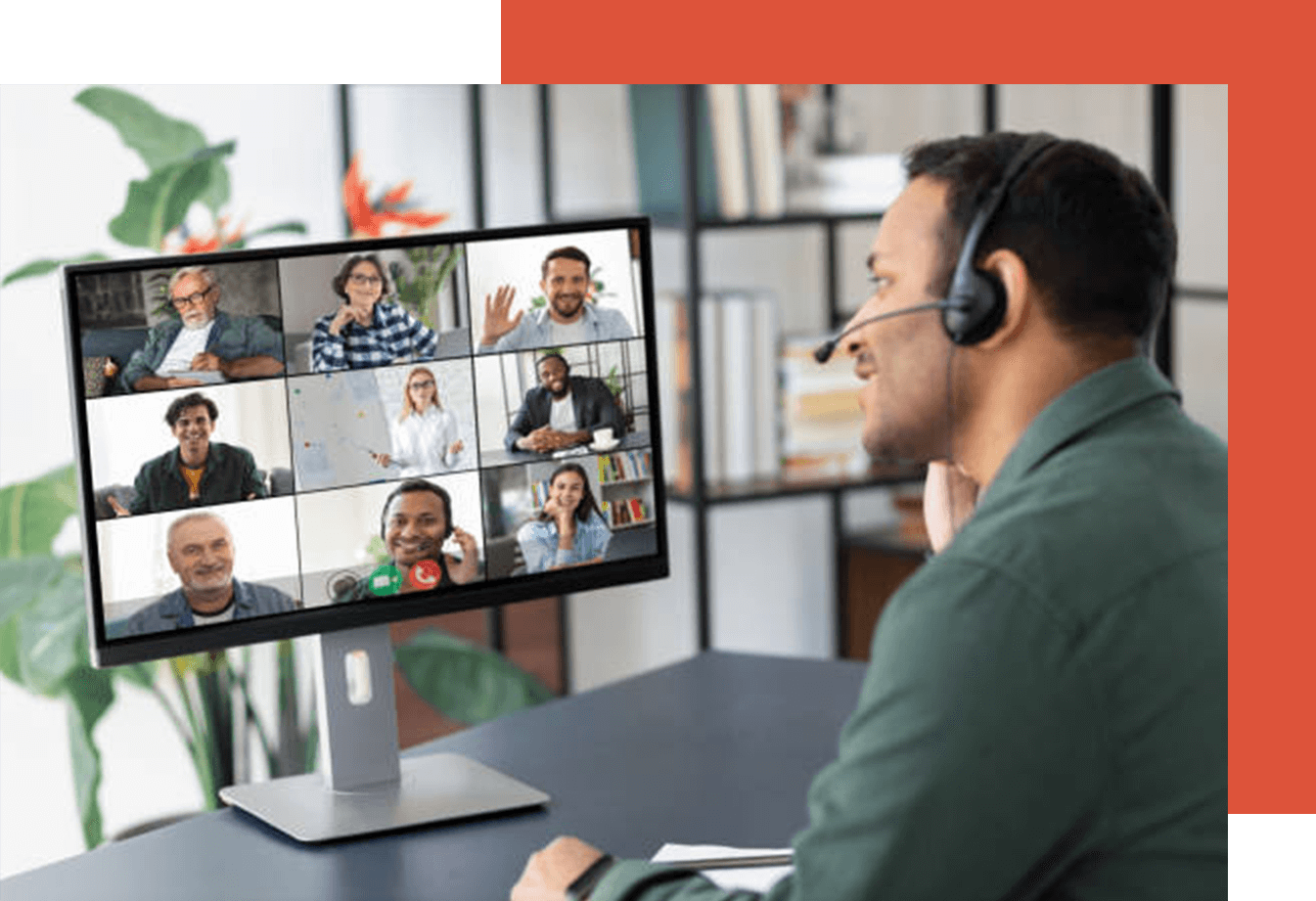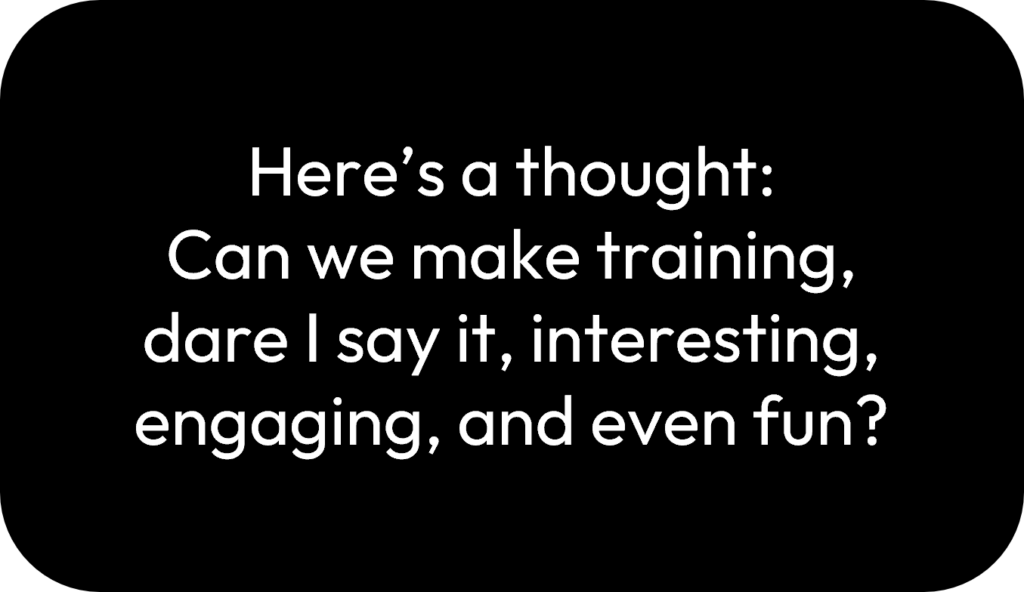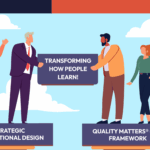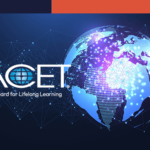Crafting Engaging and Non-Threatening Staff Training: A Comprehensive Guide
Written by Kristen Stevenson, ABD
Professional development often receives a bad rap because the lessons are often painfully dry, dull, and unengaging. It is no wonder that so many people shudder with dread at the mere thought that another required professional development training course is scheduled on the calendar.
In today’s rapidly evolving work landscape, staff training and development have become crucial elements for the success of any organization; however, the traditional approach of delivering training in a lecture-style format can be intimidating and counterproductive. That is why we have found that to truly empower your staff, it is essential to design training programs that are not only informative but also engaging and non-threatening. Implementing best practices into your training will improve training success and knowledge retention. In this blog post, we will explore practical strategies for creating a positive and enriching staff training and development experience.
Identify Your Purpose
Before jumping in and creating your professional development training, stop to identify what you hope to gain from the training experience. There are two fundamental ways to deliver your training: informational or transformational.
Informational learning increases knowledge (Rohlwing & Spelman, 2014). Do you want to present information to your staff in an informative way, such as introducing a new invoicing system, running compliance reports, or learning about a new model that will be sold in the spring? These are all examples of informational learning.
Transformational learning transforms your learners’ points of view or habits (Rohlwing & Spelman, 2014). Do you want to implement a social responsibility aspect of your company that requires changing an existing policy?
While making this decision seems obvious, the step is frequently skipped. Conducting a needs assessment before moving forward with your project is worth the time.
Know Your Audience
Adult learners must understand why they are learning something and how it will benefit them (Knowles et al., 2015). Take into consideration your learners’ background knowledge, lived experiences, and motivation levels to develop lessons that are relevant to them (Housel, 2020). Consider your staff members’ diverse backgrounds, learning preferences, and skill levels. Tailoring your training content to meet the specific needs of your audience fosters a more inclusive and supportive learning environment.
Meaningful Learning for Adults
We learn differently as adults, especially in that the training needs to apply to a real-world task or scenario to be considered relevant. This is known as authentic, or meaningful, learning. Meaningful learning actively involves learners thinking and performing tasks before they can create their own connections (Dabbagh et al., 2019). Goal or objective-driven learning ensures that the lesson is intentional and supports authentic tasks (Dabbagh et al., 2019).
Provide activities encouraging your learners to cooperate, as social activities promote deeper learning by utilizing each other’s strengths (Dabbagh et al., 2019). Despite many groans regarding group work, projects foster a sense of community and make learning more enjoyable. Your staff can learn from each other’s experiences and perspectives, creating a richer and more inclusive training environment.
The training content must be relevant to your staff’s daily tasks and challenges. When employees see the direct applicability of their learning, they are more likely to stay engaged and motivated. Use real-world examples and case studies to demonstrate how the training material can be practically implemented and is relevant to your staff’s daily tasks and challenges. When employees see the direct applicability of their learning, they are more likely to stay engaged and motivated.
Create Interactive Learning Modules
Move away from the traditional lecture-style presentations. They are boring and bring back bad memories of trying to stay awake in class. Instead, incorporate interactive learning modules into your lessons.
Edgar Dale’s Cone of Experience is typically depicted as a cone-shaped diagram with different levels, each representing a different type of learning experience. The levels are arranged from concrete experiences at the base to abstract experiences at the top. Here is a general representation of the Cone of Experience, moving from the most concrete to the most abstract:
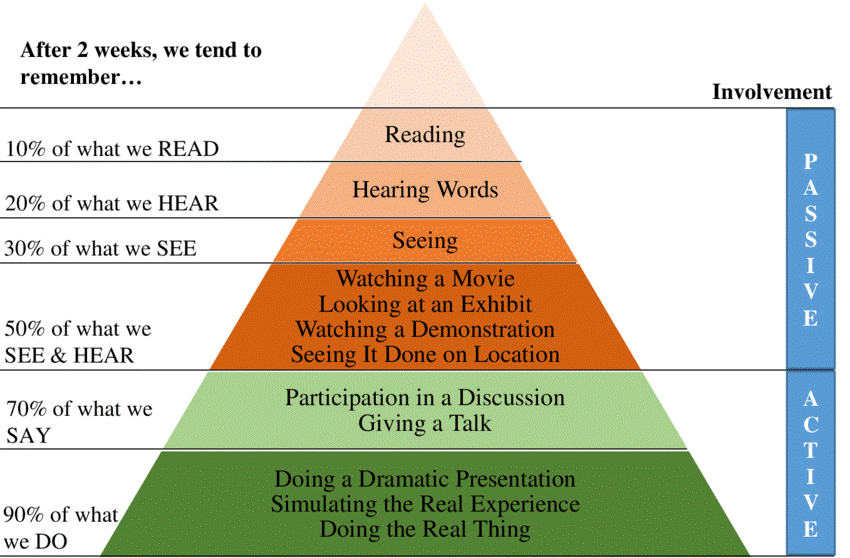
Active learning techniques include:
- Creative Tasks: Build the highest tower using marshmallows and toothpicks without speaking, complete a routine task backward, or shuffle groups to develop new insight into a department
- Games: Role-play, simulations, business development, or even board games. Use quizzes, competitions, and rewards. Make it fun!
- Out of the Box: Invite outside guests or go to a different site, such as a retreat space, or sit outside on a beautiful day to develop a different perspective
- Social Projects: Offer services from your organization, whether that is a webinar, community paper shred event, haircuts for financially disadvantaged youths, or interview advice to people re-entering the workforce
- Multiple Learning Presentation Methods, such as readings, audio recordings, and video, because people have different preferred methods of gathering information
- Problem-Solving Tasks: Use your learners’ expertise to solve a challenge that your organization faces, such as reducing waste, improving morale, or a hybrid work schedule to maintain work/life balance (Dgebuadze, 2017).
The intention behind the Cone of Experience is not to provide precise percentages of retention for each learning method but to illustrate the general idea that learners tend to retain information better through active and experiential learning compared to passive forms of instruction (such as reading or sitting in a lecture) (Dgebuadze, 2017).
Ensure a Safe and Supportive Environment
Creating a safe and supportive learning environment allows participants to feel comfortable asking questions and sharing their thoughts. This can be achieved by fostering open communication, emphasizing the value of questions, and avoiding a punitive approach to mistakes. A positive atmosphere promotes a growth mindset and reduces the threat associated with learning.
Provide Flexible Learning Paths
Recognize that individuals have different learning preferences and paces. Design training programs with flexible learning paths, allowing participants to progress at their own speed. To accommodate different learning styles, offer resources in various formats, such as videos, articles, and workshops.
Designing engaging and non-threatening staff training requires a thoughtful and inclusive approach. By understanding your audience, incorporating interactive elements, embracing gamification, promoting collaboration, highlighting real-world applications, and fostering a supportive environment, you can create training programs that empower your staff to thrive in today’s dynamic work environment. Investing in a positive and enriching learning experience pays dividends in your organization’s employee satisfaction, productivity, and long-term success.
References
Dabbagh, N., Marra, R. M., & Howland, J. L. (2019). Meaningful online learning: Integrating strategies, activities, and learning technologies for effective designs. Routledge.
Dgebuadze, M. (2017). Interactive teaching methods: challenges and perspectives. International e_journal of advances in education. https://doi.org/10.18768/ijaedu.370419
Housel, D. A. (2020). When co-occurring factors impact adult learners: Suggestions for instruction, preservice training, and professional development. Adult Learning. 31(1). 6-16. https://doi.org/101177/1045159519849910
Knowles, M., Holton, E., & Swanson, R. (2015). The adult learner: The definitive classic in adult education and human resource development. (8th ed.). Routledge.
Rohlwing, R. L. & Spelman, M. (2019). Characteristics of adult learning: Applications for the design and implementation of professional development programs. In L. E. Martin, S. Kragler, D. J. Quatroche, & K. L. Bauserman (Eds.), Handbook of professional development in education: Successful models and practices, PreK-12 (pp. 231-245). Guilford.
Varchenko-Trotsenko, L., Tlutlunnyk, A., & Terietska, T. (2019). Using video materials in electronic learning courses. Open educational e-environment of modern university. https://doi.org/10.28925/2414-0325.2019s34
